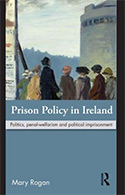Prison Policy in Ireland: Politics, Penal-Welfarism and
Political Imprisonment
 Author: Mary Rogan
Author: Mary Rogan
London, UK: Routledge, 2011
Reviewer: Taja-Nia Y. Henderson | May 2012
Mary Rogan’s Prison Policy in Ireland is being hailed as “the first examination of the history of prison policy” in the Irish Republic. The central argument of this pioneering text – part history, part penology, part political science – is that prison policy in Ireland, since the foundation of the Republic in 1922, has been shaped more by crisis moments and individual change agents than by systematic, evidence-based policy development. Rogan aims to investigate the history of the Irish Republic’s use of prisons, identify and assess those factors influencing prison policy, and articulate the links between prison policy and the “wider social, economic, political and cultural development of the Irish state.” (xv) To accomplish this goal, she employs the tools of policy analysis – an analytical method at the intersection of history and sociology which looks to archival material, law, contemporaneous accounts, and empirical data – to draw conclusions about the development of the Republic’s commitment to prisons as a desirable method of social control.
Following the methodological note that comprises Chapter 1, the book is organized chronologically, with Chapters 2 through 9 each tackling a formative period in the development of prison policy in the Republic. Each of these chapters explores the role of politics (government and ministers), “policy agents and agencies” (elected representatives, civil service workers, academics, the press and other media, interest groups), and “events” on prison policy over ninety years of Irish history. Chapter 2 (“From Independence to the ‘Emergency”), for example, tracks prison policy in Ireland from the rise of the Free State government in 1922 to the First World War. This period is notable, not merely because it marks the emergence of the independent state following the signing of the Anglo-Irish Treaty, but also because disputes over independence – specifically “divisions between those who supported and those who rejected the Treaty” – precipitated the emergence of the practice of using the state’s carceral institutions to “hold very large numbers of those who expressed their opposition to the terms of the Treaty by forceful means.” (20) The detention of these prisoners – who considered themselves “Republicans,” and who Rogan refers to by the same name – had, by Rogan’s account, a greater impact upon early-era Irish prison administration and policy than any other single factor.
In the succeeding chapters, Rogan demonstrates that, in Ireland (as in the U.K. and the U.S.), penology is political. From the stances on prison reform taken by the state’s leading political parties, to the state’s handling of political prisoners (especially in the 1920s during the Civil War, and in the 1970s during the Troubles) and the monopolization of prison policymaking by a single state agency (the Department of Justice), “the recurrent presence of a threat of ‘subversion’” influenced prison policy in the Republic. (xvi) The low prison census enjoyed in the earliest months of 1922, and which had precipitated successive calls for prison closures, was radically interrupted by eleven months of civil war and the emergence of the use of detention as a national security measure. By the summer of 1922, surging numbers of detainees led the government to actively seek to reopen, recommission, and redesignate carceral physical plants that had fallen into disuse or disrepair; at the same time, detentions in the name of national security coupled with limited space led to overcrowding and dire material conditions in the state’s prisons, and precipitated prisoner resistance efforts (including hunger strikes, escape attempts, and Republican detainees’ refusal to be lumped together with “ordinary” prisoners) that brought national attention to the prisons and the treatment of prisoners therein. Through a sustained organizing campaign, combined with resistance tactics such as refusing to perform manual labor performed by other prisoners, Republican detainees succeeded for a time in securing de facto prisoner-of-war status from the government. Such success was, however, short-lived, as personnel changes at the flagship facility in the system, Mountjoy, resulted in the government discarding any such official or unofficial policy regarding special treatment for detainees accused of crimes against the new republic. Rogan argues that the government’s handling of the Republican detainees is illustrative of the fact that prisons in Ireland serve a political function. This argument is an intriguing one, and raises significant questions for the field about the political function of prisons in other jurisdictions.
As the “Emergency” closed, and the end of the war opened a “policy window” for true reform in Ireland’s prisons, low crime and mass emigration contributed to historically low prison censuses; instead of catalyzing reform, however, low numbers led to low interest in prisons among policymakers and the public. Prison policy in the state would not become a political priority again until the 1960s, beginning with the ascendancy of masterful reformer Charles Haughey to head the Department of Justice in late 1961. Building upon David Garland’s analysis in Punishment and Welfare, Rogan explains in detail how improved living standards and economic growth catalyzed a veritable welfare revolution in 1960s Ireland, as liberalized health policy, social work, and elder care became political priorities for the ruling parties. This period coincided with the emergence of sustained penal welfarism in the state, as the Department of Justice took significant steps to improve the conditions of confinement for its prisoners. Among the reforms undertaken by the Department under Haughey’s leadership included the endorsement of an Inter-Departmental Committee responsible for remitting policy recommendations in the areas of juvenile delinquency, probation, institutional treatment of offenders, and “after-care,” or prisoner reentry initiatives. These Haughey-era innovations also contributed to a renewed focus on rehabilitation as the central aim of incarceration.
Rogan’s analysis is most intriguing in her ability to tell the history of ideas about prisons within Irish policy circles. In a sense, this text is as much an intellectual history of prisons in Ireland as it is a political or criminological study of these institutions. The best example of this involves the elusive idea that rehabilitation of the offender can be the primary function of incarceration. Rogan deftly demonstrates how rehabilitation as a concept served multiple functions in the development of Irish prison policy over time (including those epochs in which rehabilitation fell from grace as the organizing principle for incarceration in the state). Further, Rogan’s analysis is exhaustive in its identification and consideration of the myriad factors contributing to these ideas (most notably, political prisoners and the state’s ability to finance its prisons), and how those ideas were brought to bear on legislation and policy through the efforts of change agents. These strengths are impressive, and function to set Rogan’s work apart from others whose scholarship examines and critiques penal policy in Ireland (including Ian O’Donnell, Paul O’Mahony, and others). See, e.g., Ian O’Donnell, Crime and Justice in the Republic of Ireland, 2 Eur. J. of Criminology 99 (2005); Paul O’Mahony, Prison Policy in Ireland: Criminal Justice Versus Social Justice (2000).
Rogan is honest and explicit with her readers about the limitations of her analysis. For example, she explains that the inaccessibility of archival material and governmental files relating to Irish prison policy in the last two decades necessarily circumscribes the scope of her conclusions in the chapters covering this period. Otherwise, the weaknesses in Rogan’s argument are few: for example, Rogan argues that “Irish politics is characterised by centrism, with a lack of ideology apparent. Instead, pragmatic politics . . .[has had] a particular impact on the creation of change . . . .” (xv). This characterization of pragmatic centrism fails to recognize that “centrism” and “pragmatism” are themselves ideological: While not easily ascribed to one or another political party or organization, centrism and pragmatism may still function to concentrate political power in the hands of certain, privileged individuals and groups. This point is borne out in Rogan’s own analysis – as the political fortunes of Ireland’s leading parties rose and fell over the past eighty or more years, the status and condition of incarcerated people in the state has gone from bad to worse, as the prisoner (in Ireland and elsewhere) is increasingly considered and treated as a social outcast. Once afforded the titular status as prisoners of war, the state’s prisoners (whether “political” or “ordinary”) now have no such privilege, and efforts to reform Irish penal policy have resulted in a steady increase in the prison population since the mid-1990s, the adoption of the state’s first official “doubling up” policy (the sanctioning of plural-occupancy cells), inflammatory political rhetoric on crime and “criminals”, and a complete lack of external accountability measures for conditions and policy within the state’s prisons.
Notwithstanding these negligible limitations, this critical study will enrich and enliven undergraduate and graduate seminars on prisons and political culture in Ireland and comparative criminal justice in the U.K., Europe, and the U.S. Perhaps more importantly, given its pioneering scope, one hopes that this study also catalyzes further research and critical analysis of the myriad factors contributing, and failing to contribute, to prison policy in other nation-states. In the U.S., for example, there is scholarly consensus that determinate sentencing schemes, the “war on drugs,” expansive prosecutorial discretion, and “tough on crime” politics have had a pernicious impact on prison policy (both in terms of the management of day-to-day operations, as well as the pipeline to prison itself); there is far less consensus, though, on how each of these individual elements morphed systematically into a national theory of punishment. Moreover, as in Ireland, scholarship on the roles of agencies and agency personnel on prison policy in the U.S. is scant. See, e.g., John W. Roberts, The Federal Bureau of Prisons: Its Mission, Its History, and Its Partnership with Probation and Pretrial Services, 61 Fed. Probation 53 (1997). Rogan’s methodology is intriguing, yet this reader is left wondering whether such exhaustive analysis is feasible for behemothic, multi-jurisdictional criminal law systems, such as in the United States. By limiting the breadth of her study to the comparatively small Irish national system, Rogan has allowed herself room for analytical depth, and the result is a pleasure to read.
Taja-Nia Y. Henderson, Assistant Professor of Law, Rutgers School of Law – Newark


